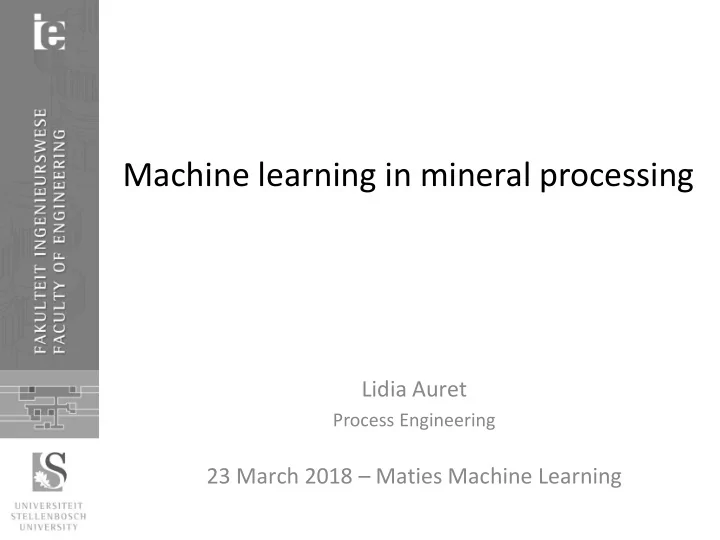

Machine learning in mineral processing Lidia Auret Process Engineering 23 March 2018 – Maties Machine Learning
Mineral processing Continuous, connected, controlled, circulating, complex, changing 2
Industrial data • Online physical property sensor data – E.g. mass flow rate, density, temperature, pressure – ~ seconds • Online image data – E.g. rocks on conveyor belts, flotation froth (mud and bubbles) – ~ minutes • Offline laboratory data – E.g. metal content, particle size distribution – ~ hours • Offline image data – E.g. microscopic grain shape and colour – ~ days 3
Abnormal event detection • Many faults and failures can occur in complex processes • Large variation in normal operating conditions due to range of allowable disturbances Disturbance D processes 4
Abnormal event detection • Missed detections can lead to suboptimal performance, equipment failure, safety and environmental violations • False alarms can lead to unnecessary downtime and loss of trust in alarm systems 5
Abnormal event detection • Unsupervised learning problem – Abundance of one class of data: Normal operating conditions • Fault detection – Feature extraction – Data description / support estimation • Fault identification – Topology extraction – Supervised learning model inspection: • Variable importance • Partial dependence 6
Abnormal event detection • Feature extraction – Sensor data correlated (through mass and energy balances, control instructions) – Sensor data noisy – Feature space represents lower dimensional, noise-free information – Residual space represents feature extraction model validity 7
Abnormal event detection • Feature extraction – Principal component analysis • 𝑼 ∗ = 𝒀𝑸 ∗ ; 𝒀 = 𝑼 ∗ 𝑸 ∗ 𝑼 – Kernel principal component analysis 8
Abnormal event detection • Feature extraction – Autoassociative neural networks (NLPCA) 9
Abnormal event detection • Feature extraction – Autoassociative neural networks (NLPCA) 10
Abnormal event detection • Data description / support estimation – Kernel density estimation – One-class support vector machines 11
Abnormal event detection • Data description / support estimation – Kernel density estimation – One-class support vector machines 12
Abnormal event detection • Data description / support estimation – Kernel density estimation – One-class support vector machines 13
Abnormal event detection • Topology extraction – Identification of propagation path of fault – Transfer entropy / lagged cross-correlation used to determine direction and strength of connections between variables 14
Abnormal event detection • Topology extraction – Identification of propagation path of fault – Transfer entropy / lagged cross-correlation used to determine direction and strength of connections between variables 15
Abnormal event detection • Topology extraction – Identification of propagation path of fault – Transfer entropy / lagged cross-correlation used to determine direction and strength of connections between variables 16
Abnormal event detection • Research approach – Scarcity of industrial data with faults detected and identified – Simulation of complex, dynamic processes with known faults – Repository with dynamic models and simulated data github.com/ProcessMonitoringStellenboschUniversity 17
Soft sensors • Ore characteristics – Metal content, particle size correlated to process performance – Captured by image data • Soft sensor – Trained model for prediction of process performance from measured process data Ore grade Particle size Process state GLCM k-NN Wavelet LDA Textons Steerable pyramids Etc. 18
Soft sensors • Flotation grade prediction with convolutional neural networks texture features and classification 19
Soft sensors • Flotation grade prediction with convolutional neural networks texture features and classification Class labels used for training Variants generated to supplement data set Bottleneck introduced to create lower dimensional feature space 20
Soft sensors • Flotation grade prediction with convolutional neural networks texture features and classification 21
Soft sensors • Flotation grade prediction with convolutional neural networks texture features and classification Interpretability important for industrial adoption 22
Challenges and opportunities • Data size, quality and fusion – Potentially massive data sets – Shifting process conditions – Online process data + offline process data + maintenance records + mine plan + purchase orders + etc. • Exploiting process knowledge – Dynamic Bayesian networks – Hybrid modelling • Process recovery – Actionable insights – Reinforcement learning 23
Questions? LAURET@sun.ac.za 24
Recommend
More recommend